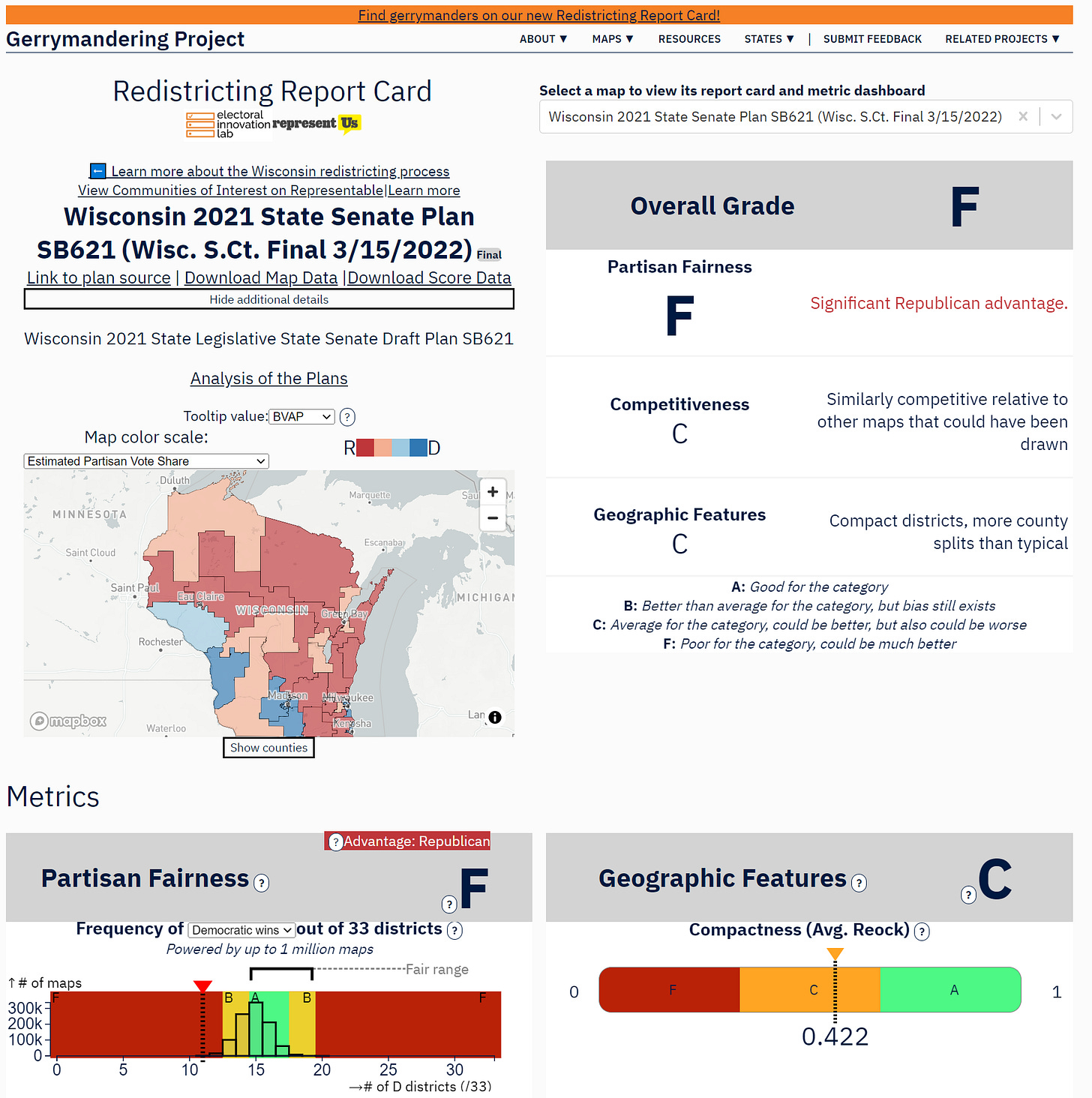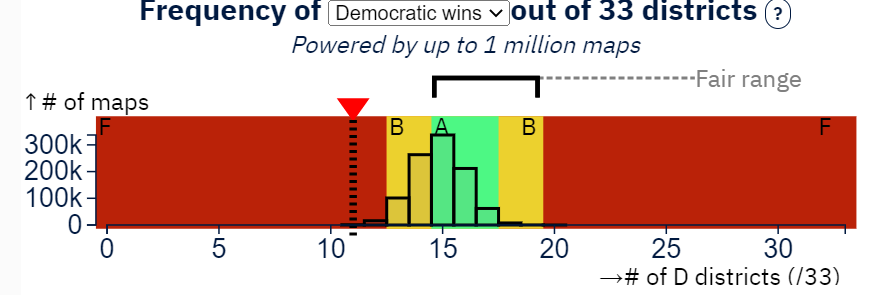The most consequential election of 2023 is next week
Out of dozens of state and local elections this year, Wisconsin's state Supreme Court primary will affect millions of people the most - maybe including you.
Next Tuesday, Wisconsin holds a statewide judicial primary in which as few as half a million ballots may be cast. This seemingly obscure election, as well as the April general election that follows, can affect millions of lives for much of this decade - and maybe our national election in 2024. Because this election is small but with outsized impact, it is a highly leveraged opportunity to make a difference with time or donations.
Wisconsin as partisan battleground: mini-America
Wisconsin is a microcosm of partisan warfare in America, in large part because it’s a swing state. Its partisan vote is routinely close to 50-50 for governor, Senate, and Presidential races. Locally, the same knife-edge balance means that small, aggressive political maneuvers can lead to large gains in power.
Partisan gerrymandering is the quintessential such maneuver. In Wisconsin, both Democrats and Republicans have struggled to gain the upper hand in redistricting. In 2010, Republicans took control of the state legislature under relatively fair maps. Then they pulled up the ladder behind them, by drawing an extreme gerrymander. And by neutral statistical measures, those maps were among the most skewed in the nation.
These maps led Wisconsin to be the focus of a prominent gerrymandering case, Whitford v. Gill. Using this and a later case in North Carolina, the Supreme Court chose to take federal courts out of the game of adjudicating partisan gerrymanders. Now such matters are left to the states.
State courts, a surviving defender of voting rights
Despite the Supreme Court’s inaction, it remains the case that party-blind mathematical methods can identify when a map favors one party excessively. Those methods rely on simple statistics and sophisticated computer simulations, and have been used successfully in many state courts, including Pennsylvania, North Carolina, New York - and Wisconsin.
However, the math leads to a remedy only if a state court is willing to use it. That’s where next week’s primary election, and the eventual runoff on April 4, come in.
The Wisconsin court is divided 4-3 between conservatives and liberals. One conservative, Brian Hagedorn, expresses some sympathy to gerrymandering claims, but takes a cautious approach. A voting rights-hostile judge, Patience Roggensack, is retiring. If she’s replaced by someone more liberal, then the court might change its approach. The court would likewise take a different stance on other election disputes, as may arise in next year’s national election.
To show you how much difference a single vote on the Wisconsin court might make, here are some maps scored by the Princeton Gerrymandering Project. The differences are striking.
Wisconsin partisans get an “F”
Often it is claimed that one person‘s good map is another person’s gerrymander. So it’s important to have an objective standard for fairness that stays the same, no matter who is in charge of drawing the lines.
The Princeton Gerrymandering Project has developed just such a standard, based on quantitative measures of racial and partisan balance. PGP can estimate a map’s performance using voting data, then run these measures through a rubric to produce letter grades and a report card. Overall, this approach works well in a variety of states, red, blue, and purple.
This is what a well-balanced map looks like:
This map was offered by the Wisconsin People’s Commission, appointed by Governor Tony Evers. Evers is a Democrat, but the commission was “tripartisan”: Democrats, Republicans, and independents. They reached a consensus map that would usually elect 16 Democrats and 17 Republicans, excellent balance. They lacked only one thing: authority to pass a map into law.
Effectively, the commission was a vehicle for Governor Evers to show the General Assembly - and all Wisconsin - what a compromise might look like. Instead, the Republican Party offered this map to Governor Evers:
This map elects 11 Democrats and 22 Republicans. We estimate that Democrats would have to win the statewide vote by 11 points to have a shot at getting a bare majority of 17 seats. It’s not impossible (Obama won Wisconsin by 13 points in 2008), but the tilt of the playing field is unmistakable.
This didn’t happen by chance. The histogram shows the results of 1 million simulations of randomly drawn maps. Such a lopsided outcome would arise by chance well under 1% of the time.
Unsurprisingly, Governor Evers vetoed this map. At an impasse, the whole process landed in Wisconsin Supreme Court, the same place it’s gone several times in the last few decades.
That court was closely divided, with Justice Hagedorn as the deciding vote. They allowed the legislature and the governor to propose alternatives, and requested that the existing map be changed as little as possible to honor communities of interest, meet other good-government goals such as compactness, and obey federal law.
The legislature submitted the same map. Governor Evers submitted this map:
…which is not bad! Its estimated performance is smack in the middle of the distribution of randomly drawn maps. It’s less favorable to Democrats than the People’s Commission map. To their credit, the Wisconsin court accepted this map along with the proposed Assembly map, writing that adding a Black-majority district was needed to satisfy the Voting Rights Act.
But enter the U.S. Supreme Court.
They’ve been increasingly hostile to the use of the Voting Rights Act to draw districts dominated by minority voters. With just a few weeks until primary elections were scheduled, they overruled this map and turfed it back to the Wisconsin court to try again. Having nearly run out of time, the Wisconsin court accepted the legislature’s map. So Wisconsin’s final grade is an F.
The Assembly has 3 times as many districts as the state Senate, 3 districts nested inside each Senate district. For Assembly maps the same story was repeated (browse the various plans here): a struggle in state Supreme Court, ending in the adoption of the Republicans’ favored map, and a grade of “F.” That map will typically elect 60 Republicans and 40 Democrats.
Speaking as a teacher, I find a process perplexing if it leads to a final grade that swings from an A to an F, with no stops in between. Surely some intermediate outcome would have been better than what emerged. In other states, including New York, North Carolina, Connecticut, Georgia, and Virginia, courts have drawn new maps.
A shift in the Court’s composition could conceivably put in a majority that was willing to take a more assertive role in redistricting. And that could make all the difference. A majority of the legislature could be elected by a majority of Wisconsinites, for the first time in well over a decade.
Anti-gerrymandering judges: Protasiewicz and Mitchell
This coming Tuesday’s primary (February 21) has four candidates, two of whom will advance to a runoff in April. See this excellent story in VICE News.
As it turns out, two of the candidates are likely to take a more liberal stance on gerrymandering. They’re pictured on the left of this photograph in an article by Peter Cameron at The Badger Project:
The more outspoken candidate is Janet Protasiewicz. She’s campaigned expressly against gerrymandering. She also favors invalidating an 1849 anti-abortion state law that has been reanimated after the overturning of Roe v. Wade. Finally, she’s the best-funded candidate, raising $2 million, which for a judicial race is a lot of money. Also likely to rule against Wisconsin’s gerrymander is Dane County Judge Everett Mitchell.
On the other side are conservatives Jennifer Dorow and Dan Kelly. There is some division between them: Kelly made it clear that he is hostile to gerrymandering claims, and indeed defended the 2011 gerrymander in court. He also won’t support Dorow if she advances to the runoff. Dorow has made her name based on cases of unclear ideology and has taken care to avoid talking about redistricting. She opposes “legislating from the bench,” which might make her either turn a blind eye to gerrymandering, or rule against it in a manner not dissimilar to Justice Hagedorn.
So it appears that advancing voting rights in Wisconsin would be closely aligned with Protasiewicz and Mitchell. If one of them wins the election, they will make the Wisconsin Supreme Court more liberal - and possibly more inclined to find a way to address gerrymandering.
Postscript: Don’t worry about the Independent State Legislature Doctrine
Meanwhile in Washington, D.C., the Supreme Court could rule on a current case in a manner that would make the Wisconsin judicial election irrelevant. I don’t think that’s going to happen.
You have probably heard about Harper v. Moore, a case currently before the U.S. Supreme Court. This case hinges on the Independent State Legislature doctrine, which would upend election law by taking state courts out of federal elections. It is a radical reinterpretation of federal and state law.
As I wrote in December, applying the Independent State Legislature theory to redistricting at a national level helps Democrats. To the extent that the Supreme Court is motivated by outcomes rather than legal principles, that doesn’t seem like something they’d be eager to do.
Furthermore, the main pro-Republican outcome of such a ruling is about to be vitiated. The Harper case was brought by North Carolina Republicans seeking to undo the actions of the North Carolina Supreme Court. But that state court has recently agreed to re-hear the case after two Republican judges replaced Democrats in last November’s election. If the court reverses itself, the Supreme Court’s decision won’t change anything in North Carolina. At that point, the easiest thing for the Supremes to do is dismiss the case as moot.
The importance of Tuesday’s primary
The primary happening next week is a top-two contest in which two of the four candidates will continue to a general election on April 4. Top-two systems are kind of buggy: one might like to have one conservative and one liberal judge advance. But there’s always the possibility that it will be two of one kind or the other. That opens the risk that the winner will not reflect the true preferences of most Wisconsinites.
Therefore it is a matter of great urgency to vote in - and to support - candidates in the primary. It could quite literally determine influence whether Wisconsinites get representative government for the coming decade. And it could affect how Wisconsin adjudicates voting rights in the 2024 Presidential election Truly, this election is pivotal.
Senate races can cost tens of millions of dollars. In comparison, this judicial election, though expensive, is still considerably cheaper. And half a million votes is only about the size of two Congressional elections. This means that your involvement can make a major impact on representation in Wisconsin - and perhaps the national election in 2024. I can’t think of a race with more leverage.
To support Protasiewicz and Mitchell, here is an ActBlue link:
To support Dorow, here is a link to her site:









